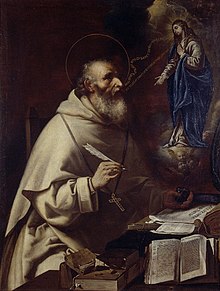
Back Albertus Magnus Afrikaans ألبيرتوس ماغنوس Arabic البيرتوس ماجنوس ARZ آلبرتوس ماقنوس AZB Альберт Вялікі Byelorussian Алберт Велики Bulgarian Alberzh Veur Breton Albert Veliki BS Albert el Gran Catalan Albert Veliký Czech
Albertus Magnus | |
|---|---|
 The Apparition of the Virgin to Saint Albert the Great by Vicente Salvador Gomez | |
| Bishop of Regensburg Doctor of the Church | |
| Born | c. 1200[1] Lauingen, Duchy of Bavaria |
| Died | 15 November 1280 Cologne, Holy Roman Empire |
| Venerated in | Catholic Church |
| Beatified | 1622, Rome, Papal States by Pope Gregory XV |
| Canonized | 16 December 1931, Vatican City by Pope Pius XI |
| Major shrine | St. Andrew's Church, Cologne |
| Feast | 15 November |
| Attributes | Dominican habit, mitre, book, and quill |
| Patronage | Those who cultivate the natural sciences, medical technicians, philosophers, and scientists |
| Other names | Albertus Teutonicus, Albertus Coloniensis, Albert the Great, Albert of Cologne |
| Known for | Teaching of theology Pioneering scholar of Aristotle Systematic study of minerals Discovery of the element arsenic |
| Scientific career | |
| Fields | |
Philosophy career | |
| Alma mater | University of Padua |
| Era | Medieval philosophy |
| Region | Western philosophy |
| School | |
| Institutions | University of Paris |
| Doctoral advisor | Jordan of Saxony |
| Notable students | Thomas Aquinas, Petrus Ferrandi Hispanus |
Main interests | |
Notable ideas | |
| Ecclesiastical career | |
| Religion | Christianity |
| Church | Catholic Church |
Offices held | Bishop of Regensburg |
| Part of a series on |
| Catholic philosophy |
|---|
   |
Albertus Magnus[a] OP (c. 1200 – 15 November 1280), also known as Saint Albert the Great, Albert of Swabia[4] or Albert of Cologne, was a German Dominican friar, philosopher, scientist, and bishop, considered one of the greatest medieval philosophers and thinkers.[5]
Canonized in 1931, he was known during his lifetime as Doctor universalis and Doctor expertus; late in his life the sobriquet Magnus was appended to his name.[6] Scholars such as James A. Weisheipl and Joachim R. Söder have referred to him as the greatest German philosopher and theologian of the Middle Ages.[7] The Catholic Church distinguishes him as one of the Doctors of the Church.
- ^ "St. Albertus Magnus". Britannica. Retrieved July 19, 2020.
- ^ Hilde de Ridder-Symoens (ed.). A History of the University in Europe: Volume 1, Universities in the Middle Ages, Cambridge University Press, 1991, p. 439.
- ^ Albertus Magnus, De IV coaequaevis, tract. 2, qu. 3.
- ^
Duchet-Suchaux, Gaston; Pastoureau, Michel (1994). The Bible and the Saints. Flammarion iconographic guides, ISSN 1258-2220. Flammarion. p. 325. ISBN 9782080135643. Retrieved November 5, 2023.
Albert of Swabia, known as Albert the Great (Albertus Magnus) [...]
- ^ "Alberti Magni e-corpus".
- ^ Weisheipl, James A. (1980), "The Life and Works of St. Albert the Great", in Weisheipl, James A. (ed.), Albertus Magnus and the Sciences: Commemorative Essays, Studies and texts, vol. 49, Toronto: Pontifical Institute of Mediaeval Studies, p. 46, ISBN 978-0-88844-049-5
- ^ Joachim R. Söder, "Albert der Grosse – ein staunen- erregendes Wunder," Wort und Antwort 41 (2000): 145; J.A. Weisheipl, "Albertus Magnus," Joseph Strayer ed., Dictionary of the Middle Ages 1 (New York: Scribner, 1982) 129.
Cite error: There are <ref group=lower-alpha> tags or {{efn}} templates on this page, but the references will not show without a {{reflist|group=lower-alpha}} template or {{notelist}} template (see the help page).